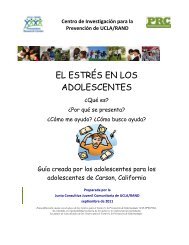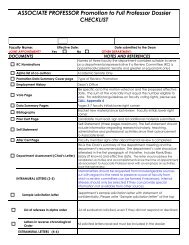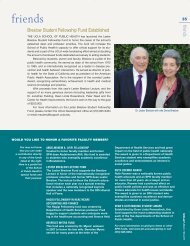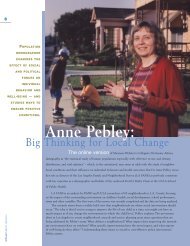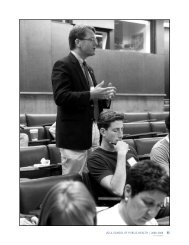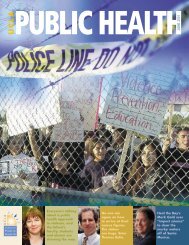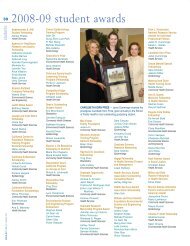Students of Color for Public Health: Engaging Diverse Communities ...
Students of Color for Public Health: Engaging Diverse Communities ...
Students of Color for Public Health: Engaging Diverse Communities ...
Create successful ePaper yourself
Turn your PDF publications into a flip-book with our unique Google optimized e-Paper software.
18<br />
GROUP MAKING<br />
ITS MARK BY<br />
FOSTERING<br />
DISCUSSION AND<br />
ACTION AMONG<br />
SPH STUDENTS<br />
COMMITTED TO<br />
WORKING ON<br />
BEHALF OF<br />
POPULATIONS<br />
OF COLOR, AND<br />
HELPING MEMBERS<br />
SUCCEED.<br />
<strong>Students</strong> <strong>of</strong> <strong>Color</strong><br />
UCLAPUBLIC HEALTH<br />
<strong>Engaging</strong> <strong>Diverse</strong> <strong>Communities</strong>,<br />
Supporting Each Other<br />
Above: Raphael Travis<br />
(lower right), a doctoral<br />
student and a founder <strong>of</strong><br />
the school’s <strong>Students</strong> <strong>of</strong><br />
<strong>Color</strong> <strong>for</strong> <strong>Public</strong> <strong>Health</strong><br />
(SCPH), also serves as<br />
youth liaison at the<br />
UCLA Center <strong>for</strong><br />
Adolescent <strong>Health</strong><br />
Promotion. Here, he<br />
leads a Youth Community<br />
Advisory Board meeting<br />
at the UCLA Challenge<br />
Course, along with<br />
Typhanye Penniman<br />
(standing, third from left),<br />
also a doctoral student<br />
and SCPH member.<br />
<strong>for</strong> <strong>Public</strong> <strong>Health</strong>:<br />
What started in 2001 as an in<strong>for</strong>mal support<br />
network among a handful <strong>of</strong> students has blossomed into a major asset at the<br />
UCLA School <strong>of</strong> <strong>Public</strong> <strong>Health</strong> and beyond. <strong>Students</strong> <strong>of</strong> <strong>Color</strong> <strong>for</strong> <strong>Public</strong> <strong>Health</strong><br />
(SCPH), now an <strong>of</strong>ficially recognized UCLA student group with funding from<br />
the school and the Cali<strong>for</strong>nia Wellness Foundation, is making its mark as a<br />
leader in recruiting populations <strong>of</strong> color to the field <strong>of</strong> public health, supporting<br />
students from diverse communities, and fostering discussion on critical issues<br />
affecting these communities.<br />
SCPH was the brainchild <strong>of</strong> several students who bonded over common<br />
backgrounds and interests, including a commitment to working on behalf <strong>of</strong><br />
populations <strong>of</strong> color. “We would get together and talk about classes and the<br />
work we were doing, work in the communities we were from, and to generally<br />
support one another as we were going through the program,” recalls Raphael<br />
Travis, who came to the school in the fall <strong>of</strong> 2000 and is now completing his<br />
doctoral studies. “Eventually it got to the point where we thought we should do<br />
something more <strong>for</strong>mal.”<br />
One <strong>of</strong> the group’s primary goals was to help entering students <strong>of</strong> color feel<br />
welcomed. “We wanted to make sure these students knew they had a place in
the school, and a community available to them that<br />
was committed to public health as a pr<strong>of</strong>ession,<br />
committed to working with disenfranchised populations,<br />
and committed to supporting them during<br />
their time as students,” says Travis.<br />
“Some <strong>of</strong> us always seemed to be bumping<br />
heads in the same circles and talking about the same<br />
issues,” adds Taigy Thomas, a doctoral student who<br />
was also among the founders. “So we decided to<br />
become more organized, so that we could have a<br />
collective voice and advocate as a group <strong>for</strong> the<br />
communities we worked in, and <strong>for</strong> ourselves.”<br />
Once that decision was made and SCPH was<br />
established, the ranks <strong>of</strong> the group quickly grew.<br />
SCPH – open to any student interested in public<br />
health issues affecting communities <strong>of</strong> color – now<br />
has approximately 100 members, including students<br />
in the master’s and doctoral programs, as well as<br />
alumni who are active supporters. It is dedicated to<br />
the recruitment, retention and graduation <strong>of</strong> students<br />
<strong>of</strong> color at the UCLA School <strong>of</strong> <strong>Public</strong> <strong>Health</strong>,<br />
and to strengthening the social support, career networking<br />
and advocacy ef<strong>for</strong>ts <strong>for</strong> the school’s students<br />
and alumni <strong>of</strong> color.<br />
The first participants were so committed to making<br />
a difference in their communities and in each<br />
other’s lives that initial activities were funded out <strong>of</strong><br />
their own pockets. But be<strong>for</strong>e long, they were receiving<br />
support from the Dean’s Office. “We approached<br />
Dean [Linda] Rosenstock to get her buy-in and she<br />
was 100 percent behind it, both in her words and in<br />
her actions, which made it a lot easier <strong>for</strong> us,” says<br />
Dr. Kynna Wright, one <strong>of</strong> the group’s original members,<br />
who has since been awarded her Ph.D.<br />
In addition to <strong>of</strong>fering SCPH support through<br />
the school’s discretionary fund, Rosenstock assisted<br />
the organization in writing grant proposals <strong>for</strong> additional<br />
funding. Since 2002, SCPH has received<br />
financial support from the Cali<strong>for</strong>nia Wellness<br />
Foundation.<br />
“This extraordinary organization was built from<br />
within from the passions <strong>of</strong> several students and<br />
their knowledge that we as a school could do better,”<br />
says Rosenstock. “In a few short years, SCPH<br />
has grown and become increasingly influential and<br />
respected.”<br />
Increasing attention is being paid to the persistent –<br />
and in many cases widening – health disparities<br />
across racial and ethnic groups, with underserved<br />
minority populations being disproportionately<br />
afflicted when it comes to many health conditions.<br />
Among SCPH’s aims is to facilitate ef<strong>for</strong>ts among<br />
students interested in working to address these concerns.<br />
“In public health we work toward social justice<br />
and making things more equitable, and it’s<br />
difficult to do that when you are constantly bombarded<br />
by the negative aspects <strong>of</strong> your community,”<br />
says Vincecia Garcia, a second-year M.P.H. student<br />
who currently serves as SCPH co-chair. “We think<br />
it’s important to take a more optimistic point <strong>of</strong><br />
view and help shed light on what students can do<br />
in a way that will inspire them to go in and make<br />
a difference.”<br />
Adds Angie Otiniano, also a second-year M.P.H.<br />
student and SCPH co-chair: “<strong>Students</strong> in SCPH are<br />
passionate about these issues because these are<br />
things that are happening in their community, not<br />
just things they’re learning about. Having this network<br />
gives us the opportunity to meet people who<br />
are interested in and knowledgeable about different<br />
aspects <strong>of</strong> public health affecting populations <strong>of</strong><br />
color, and to bounce ideas <strong>of</strong>f <strong>of</strong> each other.”<br />
Discussions on health issues <strong>of</strong> concern to populations<br />
<strong>of</strong> color range from the in<strong>for</strong>mal to the<br />
more structured, including presentations by faculty<br />
and public health pr<strong>of</strong>essionals, many <strong>of</strong> whom are<br />
involved in community-based activities similar to<br />
what SCPH members plan to pursue after graduation.<br />
“Sometimes issues affecting low-income<br />
communities don’t get as much attention as they<br />
should,” says Jabar Akbar, a doctoral student and<br />
SCPH member. “This organization not only keeps<br />
these issues at the <strong>for</strong>efront, but ensures that diverse<br />
voices are heard when we’re talking about communities<br />
<strong>of</strong> color, and that those voices include people<br />
from those communities.”<br />
SCPH members note that given how much <strong>of</strong><br />
the ef<strong>for</strong>t to eliminate health disparities affecting<br />
Doctoral student<br />
Taigy Thomas, here<br />
giving a lecture on<br />
meditation as a <strong>for</strong>m<br />
<strong>of</strong> stress reduction,<br />
was an SCPH founder.<br />
19<br />
feature UCLAPUBLIC HEALTH
20<br />
Below: Dean Linda<br />
Rosenstock with<br />
students from the Youth<br />
Into <strong>Health</strong> Pr<strong>of</strong>essions<br />
program, an introductory<br />
public health course<br />
<strong>of</strong>fered to high school<br />
and community college<br />
students in South Los<br />
Angeles; SPH staff; and<br />
members <strong>of</strong> <strong>Students</strong> <strong>of</strong><br />
<strong>Color</strong> <strong>for</strong> <strong>Public</strong> <strong>Health</strong>.<br />
populations <strong>of</strong> color involves grassroots, communitylevel<br />
strategies, it is important that more <strong>of</strong> the people<br />
implementing those strategies be people who<br />
are from those communities and understand their<br />
dynamics. “There is a heavy push to get more people<br />
<strong>of</strong> color into public health so that they can go into<br />
the communities and do the work that needs to be<br />
done,” says Typhanye Penniman, a doctoral student<br />
who has been active in SCPH since coming to the<br />
school in 2002. “If you’re familiar with the community<br />
and you’re involving the community in your<br />
work, you are more likely to know who the key<br />
people are that you need to reach.”<br />
With that in mind, SCPH has placed a high<br />
priority on encouraging talented students <strong>of</strong> color to<br />
apply to the UCLA School <strong>of</strong> <strong>Public</strong> <strong>Health</strong>. SCPH<br />
members have logged many hours at community<br />
colleges and other settings where they can talk to<br />
undergraduates in underserved communities about<br />
the field <strong>of</strong> public health and the school’s communitybased<br />
ef<strong>for</strong>ts. “If you’re a student in an affluent community,<br />
you tend to have a lot more opportunities to<br />
hear about what’s out there <strong>for</strong> you,” says Penniman.<br />
“We want to make sure students in low-income<br />
communities are getting the same in<strong>for</strong>mation.”<br />
One <strong>of</strong> the key outreach ef<strong>for</strong>ts that SCPH has<br />
helped to spearhead is the school’s Youth Into<br />
<strong>Health</strong> Pr<strong>of</strong>essions (YIHP) course. The introductory<br />
public health course, which Penniman taught last<br />
year, is <strong>of</strong>fered free <strong>of</strong> charge in South Los Angeles<br />
and draws high school and community college students<br />
from the Watts and Compton areas, giving<br />
them the opportunity to earn college credit and to<br />
be exposed to the possibilities in public health. In<br />
addition to serving as instructors and co-instructors<br />
<strong>for</strong> the course, SCPH members have been paired<br />
with the youths to serve as mentors. Among the<br />
activities is “A Day Away at UCLA,” in which YIHP<br />
enrollees are brought to the campus <strong>for</strong> a tour and<br />
further guidance.<br />
“It’s great <strong>for</strong> students from these communities<br />
to see people who look like them,” says Wright,<br />
who was involved in establishing the YIHP course<br />
and served as its first instructor. “They can see what<br />
we’re doing and know not only that we care, but<br />
that we are there to help them if they want to pursue<br />
education in public health.”<br />
SCPH outreach ef<strong>for</strong>ts have also included talks<br />
about public health to members <strong>of</strong> other student<br />
organizations at UCLA, including those that support<br />
students <strong>of</strong> color at both the graduate and undergraduate<br />
levels; participation in community health fairs<br />
throughout Los Angeles; and presentations at conferences<br />
such as the Pilipinos <strong>for</strong> Community <strong>Health</strong><br />
Pre-<strong>Health</strong> Panel, the Cali<strong>for</strong>nia State University,<br />
Northridge Pre-<strong>Health</strong> Panel, and the 4th Annual<br />
Womyn <strong>of</strong> <strong>Color</strong> Conference at UC Santa Barbara.<br />
UCLAPUBLIC HEALTH
21<br />
SCPH also works closely with the school’s Student Affairs Office at orientations<br />
and other student events.<br />
This year’s group is interested in expanding on SCPH’s reach to become<br />
involved in more <strong>of</strong>f-campus activities, as well as working with other student<br />
groups to assist with recruitment and other <strong>for</strong>ms <strong>of</strong> supporting youths in underserved<br />
communities. “We feel that since we have the privilege <strong>of</strong> being at this<br />
excellent institution in this amazingly diverse city, we should be doing more to<br />
apply what we learn in the classroom to assisting the communities we’re learning<br />
about,” says Jennifer Garcia, a second-year doctoral student.<br />
Upon entering the school as a Ph.D. student last year, Jennifer Garcia was immediately<br />
drawn to the sense <strong>of</strong> community she felt at SCPH’s social events. She<br />
was asked to serve as the group’s treasurer, and is now in her second year in that<br />
position. “Many <strong>of</strong> us have similar situations, going through the stresses <strong>of</strong> balancing<br />
school with family and work, and when you are in academia at this level<br />
as a student <strong>of</strong> color, it’s easy to feel a common bond,” Garcia says. “Knowing<br />
that there are other students I can count on <strong>for</strong> support and encouragement is<br />
extremely valuable.”<br />
Indeed, many SCPH activities have nothing to do with recruitment <strong>of</strong> new<br />
students or outreach to the community, but are simply about enhancing the<br />
social and academic environment <strong>for</strong> current students. Members <strong>of</strong> SCPH have<br />
set up their own mentoring system in which new students are given guidance by<br />
second-years and second-years by doctoral students. Many alumni also continue<br />
to be active supporters, including Wright, whom Penniman continues to identify<br />
as a role model. “Mentoring is central to the cultures <strong>of</strong> many communities <strong>of</strong><br />
color,” Wright explains. “It’s a part <strong>of</strong> who we are and what we do in the community,<br />
and it shouldn’t stop once we get to the academic level.”<br />
“This is a group in which everyone cares about making sure that we all succeed,”<br />
says Thomas. “I know that if I have a problem, these are the first people<br />
I’m going to go to <strong>for</strong> help or advice.”<br />
At the end <strong>of</strong> each academic year, a small celebration event is held <strong>for</strong><br />
graduating students <strong>of</strong> color, allowing SCPH members to celebrate their achievements.<br />
Many <strong>of</strong> the SCPH members point to that event as an annual highlight –<br />
emblematic <strong>of</strong> the level <strong>of</strong> mutual support and the sense that they and their<br />
peers are on to something important.<br />
“Whenever I feel overwhelmed,” says Vincecia Garcia, “these are the people<br />
who inspire me.”<br />
Left: Vincecia Garcia,<br />
SCPH co-chair, greets<br />
incoming students at<br />
a welcome luncheon<br />
in September.<br />
“<strong>Students</strong> in SCPH are passionate<br />
about these issues<br />
because these are things that are<br />
happening in their community,<br />
not just things they’re learning about.”<br />
—Angie Otiniano (below left)<br />
“In public health we work<br />
toward social justice and making<br />
things more equitable. We think<br />
it’s important to help shed light<br />
on what students can do<br />
in a way that will inspire them<br />
to go in and make a difference.”<br />
—Vincecia Garcia (above right)<br />
feature UCLAPUBLIC HEALTH




